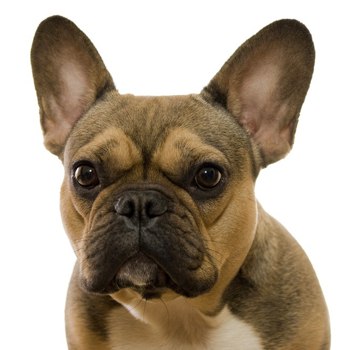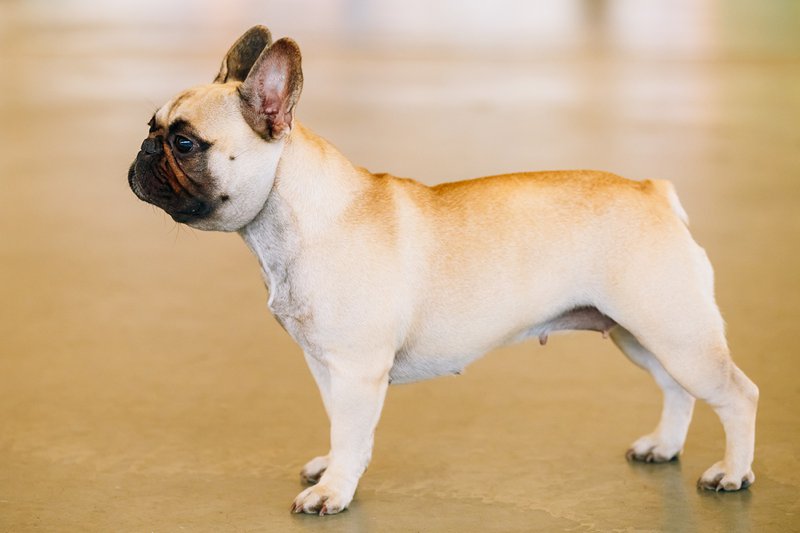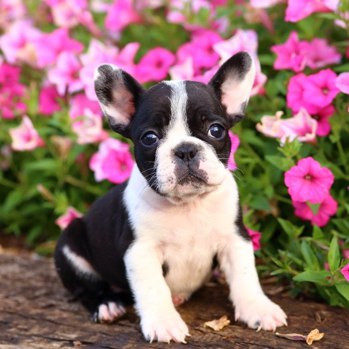French Bulldog

The French Bulldog, commonly referred to as a 'Frenchie', is a playful, lively, and intelligent dog with a sociable nature. Originally bred from the Toy Bulldog by traders who emigrated to the North of France to form the early Bouledogue Francais. These early dogs were then developed both in France and America and were endangered around the middle of the 1900s before seeing a rise in popularity to one of the most popular companion breeds today. They are small and stocky but have a lively and playful character without being overly boisterous.
Frenchies tend to be good with children and friendly with other dogs. They are keen to please which means that they are not especially difficult to train and are not known for barking. They have a short easy-to-care-for coat and do not shed heavily which means they need minimal grooming. Breeding for certain characteristics has led to some health problems which can be a welfare concern.
About & History
The French Bulldog belongs to the utility breed group and has long been bred as a companion. The breed descends from the Toy Bulldog which was taken to the North of France by tradesmen who emigrated there when they were put out of business by the industrial revolution in Great Britain. This is when the French Bulldog of today began to emerge and be defined as a breed of its own. The Toy Bulldogs soon became popular not only with workmen but also in Parisian high society. These small dogs were crossed with small French Mastiffs to create a more uniform breed throughout the 1800s and were soon known as the Bouledogue Francais. The British were outraged that the dog should be given a French name and showed little interest in the breed at this time.
The first French Bulldogs also became popular with wealthy Americans visiting France who took them back to America. These dogs either had 'rose' ears or the 'bat' ears of the French Bulldog of today. Americans tended to prefer the 'bat' eared dogs and selected for this characteristic whilst also specifying it in the breed standard. The French Bulldog became immensely popular in America where the breed was developed at the end of the 1800s and beginning of the 1900s and this popularity continued until World War I. During the Depression of the 1930s and World War II their popularity declined but the breed was maintained by a small number of American and European breeders. In the 1940s the breed was considered endangered and numbers were relatively low until a rise in popularity was seen in the 1980s. It is now a popular choice of breed around the world.
Appearance

The French Bulldog has a number of colours which are accepted by the Kennel Club. The first French Bulldogs were mostly brindle in colour, with occasional pied and white dogs. However, an American breeder began to show cream and fawn dogs in the 1950's and was very successful. Since then these colours have become more common within the breed.
- Brindle
- Brindle & White
- Dark Brindle
- Fawn
- Fawn & White
- Fawn Pied
- Fawn with Black Mask
- Light Brindle
- Pied
- White
The breed has a short, smooth coat which should have a healthy glossy appearance.
The French Bulldog is a small compact dog which has well plenty of well defined muscle giving dogs a powerful appearance despite their small size. Males normally have more exaggerated breed characteristics than females. They should measure between 24 to 35 cm high at the withers and weigh 8 to 14 kg with females being slightly smaller than males.
The French bulldog has a short neck leading to a wide chest and front end with a barrel shaped ribcage. The front legs are set reasonably far apart and should be straight and muscular with toes which are turned slightly outwards. The length of the body should be slightly greater than the height at the withers. The topline should rise slightly from just behind the shoulders towards the backend, known as a 'roach' back. This is caused by back legs which are marginally longer than the front legs. Hind legs should also be strong and muscular. The tail should be considerably narrower at the tip than the base and should be carried low. It should not be curly.
The French Bulldog has a broad, flat skull with a domed forehead. It has well developed cheeks and a strong jaw. It is a brachycephalic breed which means that the skull is relatively short in relation to its width. Exaggeration of this feature in the breed more recently means the French Bulldog can suffer from health problems related to its breathing. This is a serious welfare concern and breed clubs should be working to improve this situation. The nose should be slightly upturned and nostrils should be wide enough to allow normal breathing. Eyes should be dark, low set and rounded with a lively expression and black eyelids. The French Bulldogs ears are one of the distinctive features of the breed. They should be 'bat' like with a broad base, rounded tip and stand upright. The French Bulldog should have a free but powerful movement which appears smooth. Legs should 'double track' moving parallel to the middle plain of the body.
Character & Temperament
The French Bulldog is affectionate and has a sociable character. They are lively and playful but should not be overly boisterous. Their breeding as a companion over a long period of time means that these types of characteristics making them a good pet have been selected for. They make good family dogs as they are very tolerant with children and even protective of them but their sociable nature can mean they suffer from separation anxiety.
Adequate training and acclimatisation to being left alone in a safe environment from puppyhood can help to prevent this from becoming a problem. The breed is not generally used as a guard dog due to their sociable nature, although this characteristic combined with their playful nature means that on the whole they get along well with other dogs and pets.
Trainability

French Bulldogs are intelligent and eager to please which means they are generally easily trainable. They are also motivated by food which can be used as an incentive to help in the training process. Their attentive nature to their owner means that their recall and obedience is generally good.
House-training is not normally a problem as they are quick to learn, although as with all puppies this is helped by establishing a routine and providing sufficient access to outside space. They do not usually bark which can make them good dogs for urban environments.
Health
The average lifespan of the breed is meant to be 12 to 14 years old according to the breed club, however, a recent survey in the UK suggested this may actually be shorter and more like 8 to 10 years. The French Bulldog can suffer from several health problems which can affect the dogs’ quality of life. This is partly due to selection for certain characteristics to an extreme and there is currently a push towards more responsible breeding to reduce the incidence of these problems in the breed.
It is classed as a Category 2 breed by the UK Kennel Club and there is a watch list of characteristics that should not be over exaggerated due to their consequences on a dog’s welfare. Judges should penalise these characteristics at shows and it is important to look out for them in breeding dogs if you are thinking of getting a French Bulldog. These include:
Kennel Club Watch List
- Difficulty breathing, caused by narrowed or pinched nostrils or an excessively shortened skull or long soft palate
- Exaggerated roach in the top line
- Excessively protruding eyes or an incomplete blink
- Hair loss or scarring from previous dermatitis or any signs of any current dermatitis or skin problems in skin folds
- An incorrect bite
- An inverted, screw, tight or absent tail
- An overly short neck
Kennel Club Genetic Testing
Genetic testing is available through the Kennel Club for:
Hereditary Cataract, Early Onset (HC - EHC)
A condition where the lens or capsule becomes increasingly opaque. Dogs should be tested annually in addition to DNA testing in breeding dogs.
Degenerative Spinal Myelopathy
A progressive degenerative disease of the spinal cord which usually affects older dogs and causes a gradual loss of coordination in the back legs until the dog is eventually unable to walk. This can also be accompanied by incontinence and similar signs in the front limbs. The condition is diagnosed by exclusion and is not painful but there is currently no treatment.
Other Health Problems
In addition to these characteristics on the Kennel Club watch list the French Bulldog is also prone to several inherited traits and health problems. Some of the most common include:
Brachycephalic Syndrome
This leads to a condition called BOAS (Brachycephalic Obstructive Airway Syndrome), which is essentially caused by an excessively shortened skull, limiting the space available for internal structures. This lack of space leads to difficulty breathing and can cause the larynx to collapse.
Breathing problems are sometimes exacerbated by an excessively long soft palate. The effects of this condition are seen especially in hot or stressful conditions. If a dog does have difficulty breathing special care should be taken not to exercise it when it is hot and keep it as cool as possible.
Cleft Lip & Cleft Palate
This is a birth defect where the two cavities of the mouth and nose do not grow together properly. This can lead to nasal discharge, as well as feeding problems, depending on the severity.
Chondrodysplasia
A type of dwarfism where bone and cartilage fails to develop normally causing shortened limbs and some other abnormalities of the skull which can lead to overcrowding of teeth.
Spinal Malformations
The French Bulldog Club of England recommends screening using x-rays to detect any abnormalities.
Intervertebral Disc Disease
Herniation of the discs in between vertebrae cause compression of the spinal cord, leading to neurological signs and even paralysis if severe. Treatment depends on severity, but in many cases surgery is needed.
Cherry Eye
A protrusion of the third eyelid, which appears cherry like, caused by large eyes.
Entropion
Eyelashes are turned inwards towards the eye and this causes irritation.
Patellar Luxation
A condition where the equivalent to the kneecap in the hind leg becomes dislocated. The French Bulldog Club of England recommends testing for this.
Pulmonic Stenosis
A type of heart disease where the pulmonary artery is narrower than it should be, eventually leading to heart failure. Testing for this is also recommended by the French Bulldog Club of England.
Dermatitis
Skin problems often seen in folds of excess skin which are not exposed to sufficient oxygen, causing skin to become irritated and infections to develop.
Reproductive Health
French Bulldogs often have problems reproducing naturally and it is not uncommon for female dogs to be artificially inseminated or have to undergo caesarean sections due to their small pelvis and the large head size of puppies.
Exercise and Activity Levels
The French Bulldog is a medium energy breed which does not require a huge amount of exercise. They should be walked for around an hour a day and although some exercise off the lead within this time is ideal it is not essential. This means that they can be a good choice as pets for people leading busy lives or living in an urban environment and can adapt well to living spaces without gardens if given appropriate walking. Due to the French Bulldogs predisposition to breathing problems care should be taken not to exercise them vigorously or expose them to high temperatures.
Grooming
The French Bulldog has a short coat which does shed, but not excessively. Occasional brushing at home should be more than enough to stop shedding around the house. Despite their minimal grooming needs the breed can be prone to skin problems which means they may need bathing with special shampoos or other treatments.
Famous French Bulldogs
Despite their enormous popularity as companion dogs there are few if any examples of French Bulldogs in popular culture. Early French Bulldogs in France were depicted by Toulouse Lautrec in some of his paintings.
Cross-Breeds
Popular French Bulldog crossbreeds today include:
- Frenchton – Cross between a French Bulldog and a Boston Terrier
- French Boodle – Cross between a French Bulldog and a Poodle
- Frug – Cross between a French Bulldog and a Pug
- French Pomerdog – Cross between a French Bulldog and a Pomeranian
- French Bullweiler – Cross between a French Bulldog and a Rottweiler
- French Bullhuahua – Cross between a French Bulldog and a Chihuahua
- Frengle – Cross between a French Bulldog and a Beagle
- French Bull Jack – Cross between a French Bulldog and a Jack Russell Terrier
- Miniature French Schnauzer – Cross between a French Bulldog and a Miniature Schnauzer

